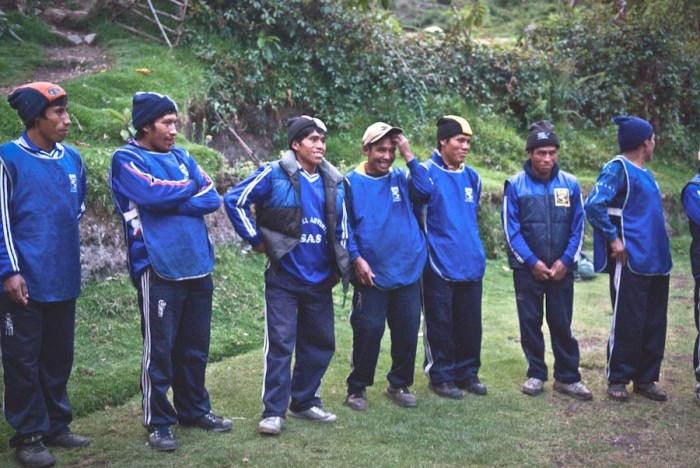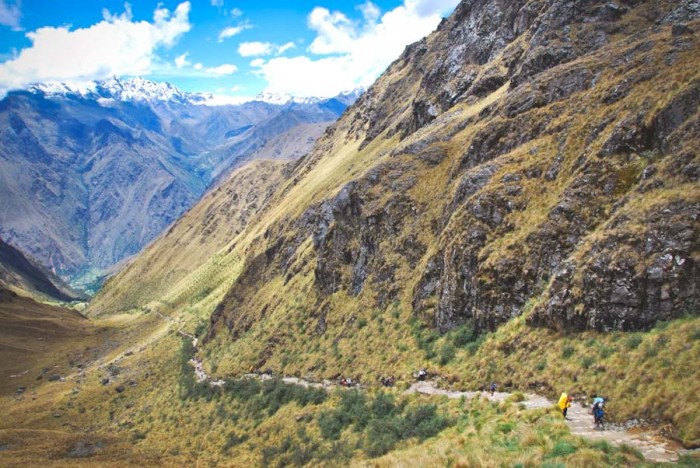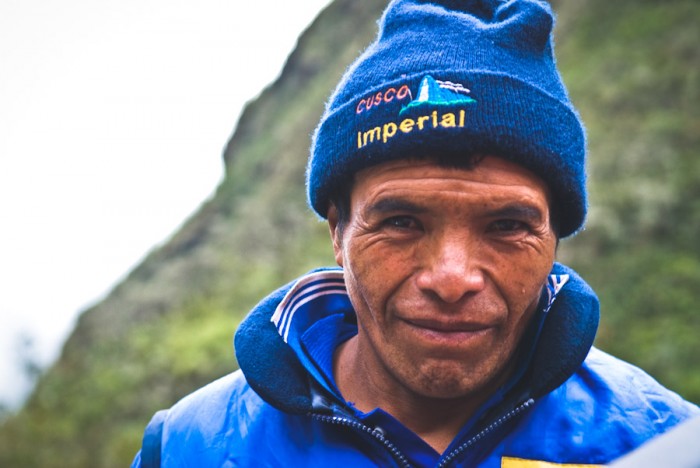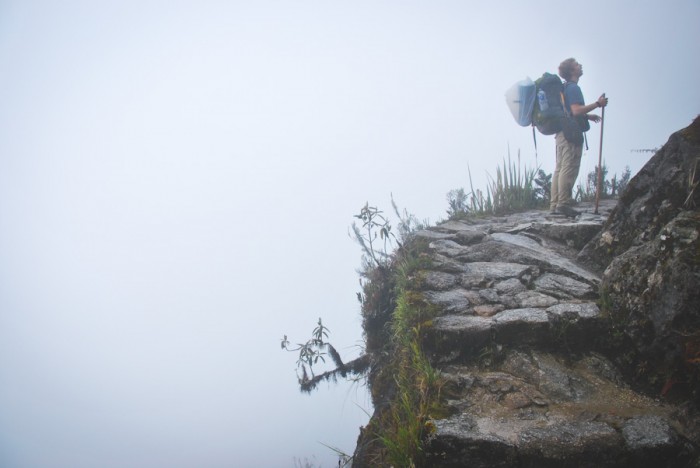When we got to the temple of Phuyupatamarca on the third day of the Inca Trail to Machu Picchu, it was hard not to feel a certain sense of achievement.
We stood on mossy stones placed by ancient builders and gazed through thick mist at the hints of a vast green valley below. Winded and sore, we had made it here on our own two feet.
Well, strictly speaking, we had more than two feet.
The 16 hikers on our four-day trip were accompanied by a support staff of 19 porters, two guides, and a cook, giving us each an average of 4.75 feet, and the feeling that we were members of a royal hunting party.
We tourists sported fresh Gore-Tex raincoats, beefy hiking boots, and colorful daypacks. We would have looked just like a North Face ad, if not for the 19 sandal-clad locals in tow, hefting bags the size of washing machines that contained not just tents and food, but also the iPads, sacks of granola, and fuzzy socks that we tourists didn’t want to carry.
The use of indigenous porters in Peru is nothing new. Historian John Hemming writes that, “From the outset of the Conquest, Spanish armies and expeditions had commandeered regiments of native porters, and it was manifest that this abuse contributed directly to the country’s depopulation.”
Our Inca Trail tour group was a pretty affluent crowd, including a Dutch ophthalmologist, a British market analyst with her actuary brother, and a software engineer from New York. Few spoke Spanish.
The porters were all men, many in their mid-twenties but some as old as 60. Some spoke only Quechua, the region’s native language. They typically had children and spouses, who they leave behind to hike the trail for as many as 20 days per month.

After kicking off our tour with a group photo, name game, and two hours of walking, we stopped for lunch. This and all of our subsequent meals would consist of an appetizer, main course, coffee and dessert served under a canopy tent.
Once we’d eaten our fill, our guide began to manage our expectations for the next two or three hours of hiking. We were reminded to walk at our own pace because “the Inca Trail is not a race.”
It may have felt that way for the porters, who arose before daybreak to serve us coffee in our tents, ate quickly, and began racing ahead to the next stopping point as soon as our breakfast was on the table. They bent deeply at the waist to endure the uphills and handled the downhills at near-sprint, a knee-saving tactic.
But for us, the luxury continued. At the end of day three — nearly 40 kilometers into the hike — the group’s head cook whipped up a cake complete with a frosted inscription wishing us a good day at Machu Picchu.
In 1552, Dominican friar and human rights advocate Bartolomé de las Casas wrote, “[Spanish settlers] used natives like pack animals. They have sores on their shoulders and backs, like much-abused beasts.”
Las Casas and his supporters inspired the Spanish crown to issue the New Laws, which outlawed the encomienda forced-labor system and forbade the “lading of Indians.” Although these laws were widely ignored, they reflected Spanish authorities’ uneasiness with using people as beasts of burden.

Five centuries later, Peru passed the Porter’s Law. The 2001 legislation limited loads on the trail to 20 kilograms (about 45 pounds), set a minimum wage of roughly $16 per day and required tour companies to provide porters with adequate food and clothing. A 2012 article in La Republica found that the law is routinely flouted, with porters sometimes forced to carry up to 40kg.
Such work takes a toll on the body. A 2013 study published in the Journal of Global Health Studies found that back pain was the most common health complaint among residents of the Sacred Valley region of Peru, where most porters are from.
“In these patients, we are seeing the culmination of a lifetime of heavy lifting and strenuous labor,” said Bryan Sisk, one of the study’s authors.
“I have worked as a head porter for 28 years. Things have barely improved. It’s almost the same. Only the weight has slightly changed. The food remains the same. They don’t give us a tent,” said Anastasio Phuturi Echame in the recent documentary “Porters of the Inca Trail.”
Michelle Graham, co-founder of the Llama Path tour agency, which promotes ethical treatment of porters, believes that conditions are slowly improving, but acknowledges that many porters are still overburdened and underpaid.
“More porters are given uniforms. You can put some porters in trousers, but what are they eating? Where are they sleeping? You don’t know,” Graham said.
In some ways, conditions are getting worse. Bathroom facilities on the trail are somewhat limited, so many agencies now have porters carry chemical toilets.
“In any other situation, we would see that person carrying toilets as totally discriminated against,” Graham said.

If the laws were better enforced, would there be anything wrong with paying indigenous people to schlep gear through the Andes, set up tents and serve morning coffee?
Imagine an acquaintance had decided to hike the Inca Trail and asked you to come with them. They might say the following:
“Although I am physically capable, I believe that carrying heavy objects like food, tents, and clothing leaves me no room to enjoy the trail. I’ll pay you, I just ask that you arrive to the campsite ahead of me to set up the tent and begin cooking my dinner.”
Inca Trail tourists make the same request of poor subsistence farmers. By dint of economic privilege, one group walks and the other carries.
The irony is that the Inca civilization that built the marvels that tourists come to see is not extinct — its culture is carried on by the very people who are employed as porters. Andean mountain communities still grow crops on Inca terraces, speak Quechua, and practice traditional medicine.
Often, tourists complete the Inca Trail without ever realizing the persistence of the people who built it.
Porters are no longer enslaved and they no longer die of hunger and exhaustion after being pushed over hundreds of miles. And today’s adventure tourist is more likely looking for great photos than for gold.
But along the Inca Trail, the descendants of conquistadors are still enlisting the descendants of the Incas to carry their heavy loads.
[ts_fab authorid=”246″ tabs=”bio”]
[ts_fab authorid=”245″ tabs=”bio”]



Wow, this was a real eye-opener. Like many who grew up looking at photos of Machu Picchu in National Geographic, I have often dreamed of making this trek. I will rethink it – or at least see if I can check out the way different companies treat their workers.
Your comment makes me fell sad because we are a local tour operator and the porters we hire to travel with. have food, equipment like shoes, t-shirts, caps but we dont pay attention where they sleep or eat, usually they do that in the cooking tent or dining tent and in some places there are cabins for porters, but this has a reason, the market, some operators offers inca trail at 350 USD with groups of more than 12 people there is no way to cover all the cost of giving porters a better treatment, i recommend to pay more than 550 USD and no more than 700 USD for a trek in a group of 8 people tops, and ask for more details not only what is included what is the treatment to the personal service, i support a sustainable tourism it’s difficult to compete but ask your tour agency for that details, or make another routes like salkantay or lares where you can use horses or lamas. Cusco is beautifull there are so many places to know, not only the inca trail.
Porters are local, because they know the route, they live around the route, they are experts doing the trail.
Machu Picchu is one of the most amazing places in the world, so it is considered one of the 7 Wonders. some say they lost city of the Incas, but you must visit this amazing Inca citadel to see its majesty. and we have to respect every body, they show us their culture and they are proud about IT.
Machu Picchu has two big important areas: to the south, the agriculture area is made up of terraces, aqueducts, etc. To the north, the urban area is the city with its temples, observatories, workshops, and sacred burial plots. There are three ways to reach Machu Picchu: by helicopter (30 minute flight), by train (4 hours to Aguas Calientes), and through the trekking route known as the “Inca Trail” (a three day journey). The Inca trail to Machu Picchu is one of the most spectacular routes in the world, part of the 23,000 kilometers of road that the Incas built all around South America.
Good Information. The Salkantay Trail is the Best Alternative Track of the Inca Trail to Machu Picchu. 4 days trek is create for people on good fits and physical shape who loves the top challenging. Lace up your hiking boots, and follow us on this adventure. Get to see the most of the climates, and ecosystems in one single trip to Machupicchu
i love your pic about Inca Trail and your post is very informative
very good information that you published, and the most interesting thing was to write about the porters on the Inca trail, excellent work.
The Salkantay Trek is a hiking in south America and an alternative to the traditional Inca Trail for reaching Machu Picchu.
one of the best place to visit in Peru I also visited machu Pichu and the information provided by is good. Thanks for sharing.
great post, I love mountainous landscapes
Excellent post, I love the support to the porters, they represent the sustainability of the Inca Trail and they will be forever. A large part of the porters are from the communities of Lares and close to Ollantaytambo.
I love how you highlight it in the post!
Regards
It looks great! I wasn’t aware you can do it solo, that’s good to know 🙂 Thanks!